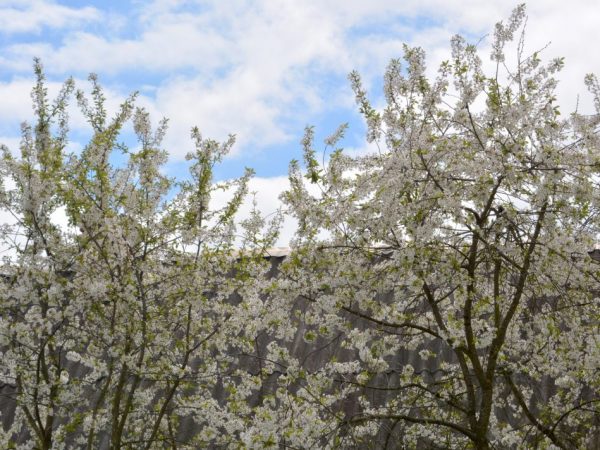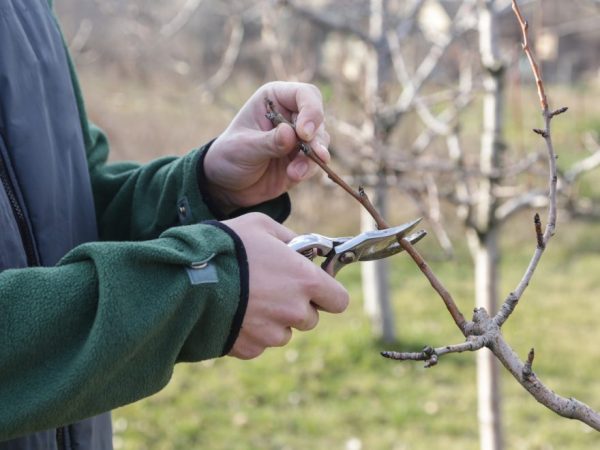Recommendations for the care of pears in spring
If the care of the pear was carried out in violation of agricultural technology, then in the fall the plant will not be able to lay buds for the next year. In some cases, even the death of a tree is possible.

Recommendations for the care of pears in spring
Care features
Caring for pears in the spring is different from gardening in the fall. The cultivation characteristics depend on environmental factors and weather conditions.
The main care of pear seedlings is the following:
- pruning;
- top dressing;
- watering;
- disease prevention;
- pest control.
Caring for old trees is different from caring for young ones. The methods of pruning the crown differ, as well as the rules and frequency of applying mineral fertilizers. If you do not follow the rules, then the young plant may die. The yield of mature trees also largely depends on their care.
Caring for pear seedlings in spring:
- removing the cover from the trunk;
- treatment of bark injuries;
- applying a protective layer;
- watering the plant;
- application of mineral fertilizers.
Pruning
Pruning is one of the main steps in spring maintenance. It is with this process that the gardener's spring work begins, and they can be aimed both at forming the crown and at adjusting the growth of branches. Actions should be taken when the daytime air temperature rises above 5 ° C.
Care for a young pear begins only after all the buds bloom on the seedling. Then you can see the direction of growth of the branches.
Young plants have a large number of shoots in spring, so by tying up the plant and directing the branches in the right direction, you can easily achieve the desired crown shape in an adult fruiting plant.
Cutting methods:
- Palmette: leave a central branch that is not touched, but form the width of the plant with lateral branches. It is difficult to harvest such trees without special equipment.
- Sparse-tiered: on each "floor", several multidirectional skeletal branches are left. This increases natural ventilation.
- Rounded: the branches are trimmed to approximately the same length and the inward shoots are removed. The crown tapers slightly towards the top of the head. You can control the height of the tree for easy picking of ripe fruits.

Crop in a convenient way for you
The choice of technique should be carried out in accordance with the recommendations for the care of each individual species and variety. If dry branches are found on the trees that were not removed during the autumn procedure, then they should be cut as close to the branches as possible. If, during the formation of the crown, the plant begins to lose too much juice, the sections must be sealed with garden pitch.
Top dressing
In the spring, caring for pears requires the introduction of mineral fertilizers. Young plants need more nutrients than old and long-term fruiting trees.
Caring for seedlings in the spring involves feeding various types:
- Foliar, when the plant is sprayed over the foliage with active preparations from a spray bottle.For these purposes, you should use a solution prepared from 2 tbsp. l. mineral fertilizer (nitrate) and 10 liters of water.
- Root, when mineral fertilizer (manure, humus or compost) is applied in the most familiar way for many: buried in ditches laid close to the trunk.
For plant nutrition, you can use wood ash, as well as substances containing potassium, phosphorus and nitrogen. You can also use potassium permanganate solution to improve the soil.
All mineral fertilizers should be placed at least 20 cm from the trunk. After adding mineral solutions, after about 60 minutes, the plant should be watered abundantly. Caring for young pear seedlings in the spring involves laying fertilizer a little closer to the trunk. This is due to the fact that biennial plants do not yet have a spreading root system.
Watering
In dry spring, the garden should be watered. There are two ways to do this correctly:
- Sprinkling. Rotating sprayers are installed on the site. This method is to wet the soil as much as possible. The disadvantage of this method is that the plantings should be watered for several days.
- At the root. To water the seedlings in this way, gardeners dig a deep ditch around the tree trunk and then fill it with water. The advantage of using this method is speed, but the disadvantage is that the next day the soil around the trunk will be tightened and it will have to be loosened.
Watering should be done at least 3 times per season:
- at the time of flowering;
- in the phase of active fruiting;
- during the laying of fruit buds for fruiting in the next season.
The soil should be mulched. Sowing at the siderat trunk is also allowed. Fast growing and low growing varieties are best: any cruciferous plant, phacelia or clover.
If the spring is wet, then the care of a young pear does not provide for watering. This can lead to root moistening and rotting. As a result, the plant will die.
Pest control
The pear is exposed to:
- viral spotting;
- gall mites;
- suckers;
- red apple tick.
- blood aphid;
- leaf rollers;
- mosaic disease;
- powdery mildew;
- scab;
- moth;
- cytosporosis;
- black cancer.
Caring for a pear in spring is aimed at preventing disease and preventing pest damage:
- In early spring, the plant and the soil around it are treated with a solution of Bordeaux liquid. 3 times with an interval of 15 days.
- The trunk, as well as the lower branches, are whitened with a solution of lime. This prevents the appearance of clutches and pest larvae. The caustic substance can also kill shallow bark beetles.
- Treatment of the trunk and branches until the buds open and bloom with broad-spectrum insecticides. These substances are able to save gardeners from an unpleasant neighborhood in the future.
- Arrangement of traps for small insects emerging from the soil and moving along the trunk from the outside.
The introduction of mineral fertilizers will strengthen the pear's immunity. Top dressing should be done according to the instructions on the packaging by the manufacturer.
Growing on poor soil will not bring the desired result. The fruits will grow small and crooked. Even a high-quality varietal tree will not produce a good and tasty harvest. Such plants are more likely than others to get sick or even stop growing and developing. But this process is reversible. The tree can be brought back to normal and made to bear fruit.
Conclusion
Both young seedlings and old trees need the help of a gardener. Correct actions will help fruiting crops to form fruit buds and renew the crown.
In terms of importance, spring work is many times greater than the care of pears in autumn. If you properly care for the pear in the spring, then in the summer a bountiful harvest of fruits is guaranteed.


